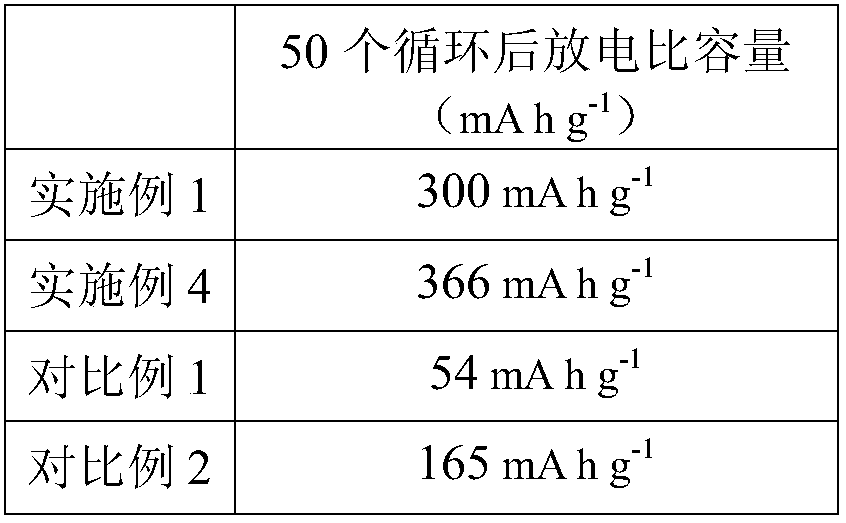Method for synthesizing porous carbon micro-sphere based on phase separation
A porous carbon, phase separation technology, applied in the preparation/purification of carbon, carbides, tungsten/molybdenum carbides, etc., can solve the problems of poor high current discharge capacity, limit specific capacity, etc., and achieve high charge-discharge ratio. The effect of capacity, uniform pore distribution, and good cycle stability
- Summary
- Abstract
- Description
- Claims
- Application Information
AI Technical Summary
Problems solved by technology
Method used
Image
Examples
Embodiment 1
[0012] Example 1: 10g of AMM (ammonium molybdate) and 4.5g of PVA (polyvinyl alcohol) were respectively dissolved in 500ml of deionized water, and then uniformly stirred in a 60°C water bath for 10h to form a uniform and transparent mixed solution. The solution is spray-dried to obtain the precursor, and the speed is 1200ml h -1 , The inlet temperature is 220℃, and the outlet temperature is 100℃. The collected precursor was vacuum dried at 80℃ for 12h, then in argon atmosphere for 1℃min -1 The rate of heating to 900 ℃ and keeping for 2h to get Mo2C@C red blood cell-like carbon spheres.
Embodiment 2
[0013] Example 2: 10g of AMM (ammonium molybdate) and 4.5g of PVA (polyvinyl alcohol) were dissolved in 500ml of deionized water, and then uniformly stirred in a 60°C water bath for 10 hours to form a uniform and transparent mixed solution. The solution is spray-dried to obtain the precursor, and the speed is 1200ml h -1 , The inlet temperature is 220℃, and the outlet temperature is 100℃. The collected precursor was vacuum dried at 80℃ for 12h, then in argon atmosphere for 1℃min -1 The rate of heating to 900 ℃ and keeping for 2h to get Mo2C@C red blood cell-like carbon spheres. 0.1g erythrocyte-like Mo2C@C was added to 65ml 1% HNO3 solution, and then heated at 80°C for 20h. Subsequently, the sample was centrifuged several times and vacuum dried at 80°C for 12 hours, and then heat-treated at 500°C for 2 hours to obtain porous erythrocyte-like carbon balls.
Embodiment 3
[0014] Example 3: 10 g of AMM (ammonium molybdate) and 4.5 g of PVA (polyvinyl alcohol) were dissolved in 500 ml of deionized water, and then uniformly stirred in a 60° C. water bath for 10 hours to form a uniform and transparent mixed solution. The solution is spray-dried to obtain the precursor, and the speed is 1200ml h -1 , The inlet temperature is 220℃, and the outlet temperature is 100℃. The collected precursor was vacuum dried at 80℃ for 12h, then in argon atmosphere for 1℃min -1 The rate of heating to 900 ℃ and keeping for 2h to get Mo2C@C red blood cell-like carbon spheres. 0.1g of erythrocyte-like Mo2C@C was added to 65ml of 3% HNO3 solution, and then heated at 80°C for 20h. Subsequently, the sample was centrifuged several times and vacuum dried at 80°C for 12 hours, and then heat-treated at 500°C for 2 hours to obtain porous erythrocyte-like carbon balls.
PUM
 Login to View More
Login to View More Abstract
Description
Claims
Application Information
 Login to View More
Login to View More - R&D
- Intellectual Property
- Life Sciences
- Materials
- Tech Scout
- Unparalleled Data Quality
- Higher Quality Content
- 60% Fewer Hallucinations
Browse by: Latest US Patents, China's latest patents, Technical Efficacy Thesaurus, Application Domain, Technology Topic, Popular Technical Reports.
© 2025 PatSnap. All rights reserved.Legal|Privacy policy|Modern Slavery Act Transparency Statement|Sitemap|About US| Contact US: help@patsnap.com

